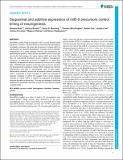Sequential and additive expression of miR-9 precursors control timing of neurogenesis
Abstract
MicroRNAs (miRs) have an important role in tuning dynamic gene expression. However, the mechanism by which they are quantitatively controlled is unknown. We show that the amount of mature miR-9, a key regulator of neuronal development, increases during zebrafish neurogenesis in a sharp stepwise manner. We characterize the spatiotemporal profile of seven distinct microRNA primary transcripts (pri-mir)-9s that produce the same mature miR-9 and show that they are sequentially expressed during hindbrain neurogenesis. Expression of late-onset pri-mir-9-1 is added on to, rather than replacing, the expression of early onset pri-mir-9-4 and -9-5 in single cells. CRISPR/Cas9 mutation of the late-onset pri-mir-9-1 prevents the developmental increase of mature miR-9, reduces late neuronal differentiation and fails to downregulate Her6 at late stages. Mathematical modelling shows that an adaptive network containing Her6 is insensitive to linear increases in miR-9 but responds to stepwise increases of miR-9. We suggest that a sharp stepwise increase of mature miR-9 is created by sequential and additive temporal activation of distinct loci. This may be a strategy to overcome adaptation and facilitate a transition of Her6 to a new dynamic regime or steady state.
Citation
Soto , X , Burton , J , Manning , C S , Minchington , T , Lea , R , Lee , J , Kursawe , J , Rattray , M & Papalopulu , N 2022 , ' Sequential and additive expression of miR-9 precursors control timing of neurogenesis ' , Development , vol. 149 , no. 19 , dev200474 . https://doi.org/10.1242/dev.200474
Publication
Development
Status
Peer reviewed
ISSN
0950-1991Type
Journal article
Description
Funding: This work was supported by a Wellcome Trust Senior Research Fellowship (090868/Z/09/Z) and a Wellcome Trust Investigator Award (224394/Z/21/Z) to N.P. and a Medical Research Council Career Development Award to C.S.M. (MR/V032534/1). J.B. was supported by a Wellcome Trust Four-Year PhD Studentship in Basic Science (219992/Z/19/Z). Open Access funding provided by The University of Manchester.Collections
Items in the St Andrews Research Repository are protected by copyright, with all rights reserved, unless otherwise indicated.

